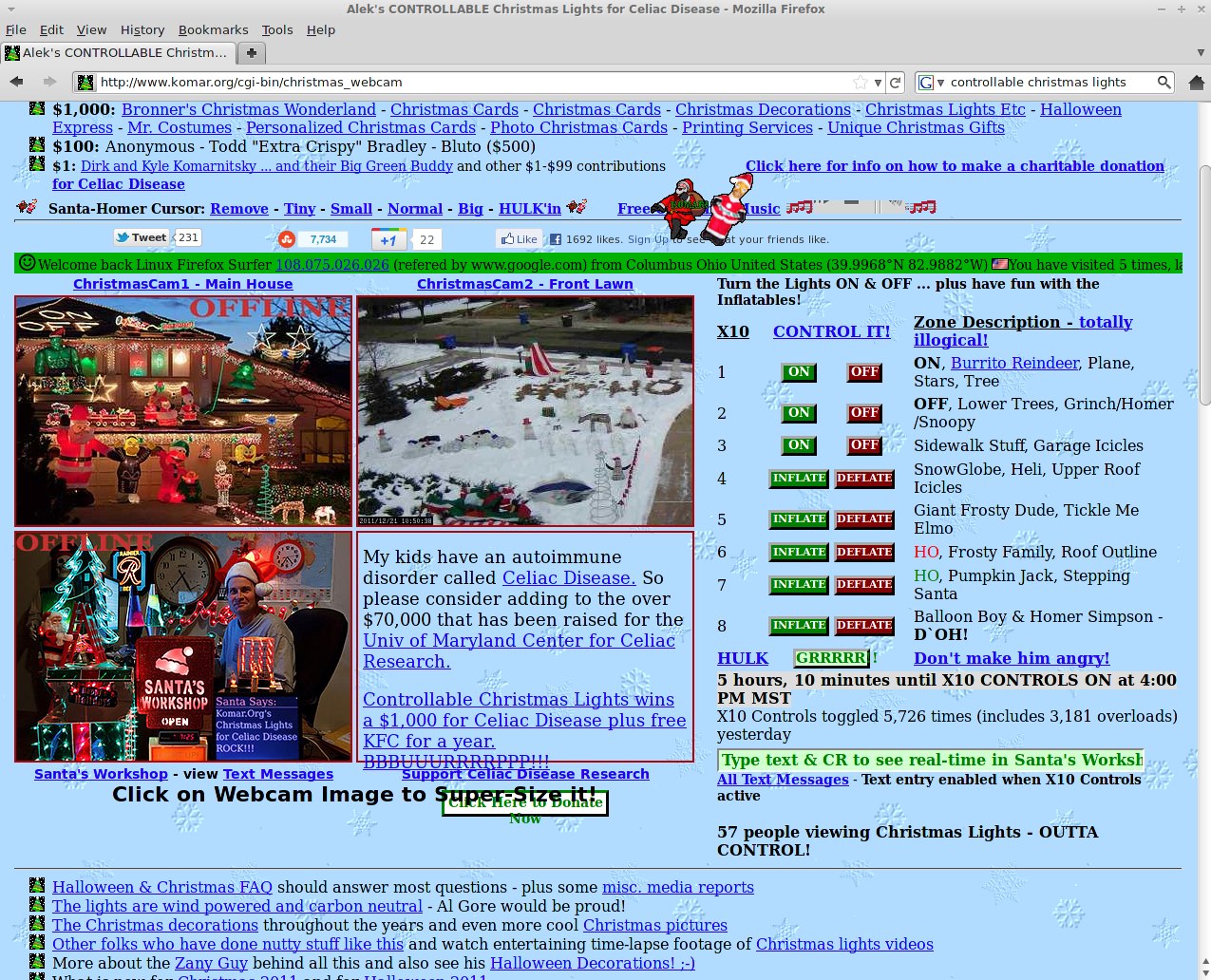Most of us have holiday traditions, like celebrating with family, putting up decorations, or watching A Christmas Story over and over again. One of my favorite holiday traditions? Checking out the madness of Alek Komarnitsky’s Linux-powered controllable Christmas lights.
Every year, Komarnitsky puts up his display with more than 20,000 lights and a slew of decorations. But that’s not that unusual. Komarnitsky’s not the only guy who goes gonzo with the Christmas lights, but he does give it an unusual twist. Komarnitsky puts his display online for all to see, and lets visitors to his site control the lights and inflate/deflate the giant mascots in the display.
Explain The Madness
 Why is Komarnitsky ensuring that, if the aliens ever attack, his house will be the first seen from space? It’s all in good fun, but also for a good cause. Komarnitsky’s boys Dirk and Kyle have Celiac Disease. This is an autoimmune disorder that causes an intolerance of gluten from wheat, barley, oats, and other grains.
Why is Komarnitsky ensuring that, if the aliens ever attack, his house will be the first seen from space? It’s all in good fun, but also for a good cause. Komarnitsky’s boys Dirk and Kyle have Celiac Disease. This is an autoimmune disorder that causes an intolerance of gluten from wheat, barley, oats, and other grains.
One way to deal with Celiac Disease is to avoid foods with gluten, but that’s not an easy task. As Komarnitsky says on his site, he hopes to see a cure so that “when my boys grow up, they can eat pizza and beer!”
So Komarnitsky is doing the site to raise awareness and funds to help cure Celiac Disease. So far, the site has done impressively well and has raised more than $70,000 for University of Maryland Center for Celiac Research.
The What and How
The site allows users from anywhere in the world to view the three Webcams that display the house, lawn, and “Santa’s workshop” (Komarnitsky’s office). They can also control the lights and inflate/deflate the various inflatables that Komarnitsky has festooned the house with.
The Web server front-end for the setup is “pretty standard LAMP (Redhat Linux, Apache, Mod-Perl)” says Komarnitsky. When users try to manipulate the lights or inflatables, Komarnitsky says that the query goes back to an IBM ThinkPad running Ubuntu that’s more than seven years old.
“This sends the requested “zone ON/OFF” command that a wireless X10 TM751 receiver gets,” says Komarnitsky. “That is boosted with a XTB-IIR/III X10 signal booster (from JVDE – great guy running a one-man shop who does old-school craftsmanship quality) which ensures the command gets ‘punched through’ the house wiring to a variety of X10 Super Sockets and Appliance/Lamp Modules all over place.”
The public Web servers, also running Red Hat, pull images from the D-Link DCS-6620G Web cams and send them to you. Komarnitsky says it’s “basically a rebroadcast approach since my Comcastic house connection would otherwise be totally saturated. X10 has a latency of a little over a second and there’s another second or so delay on getting the image to ‘ya … so the commanded changes aren’t instantaneous.”
You might notice that the site design is a bit old school. It hasn’t changed a great deal since the site launched years and years ago. Komarnitsky says the site is put together with Perl, HTML, CSS, and JavaScript and has “scaled well” even with newer versions of Chrome, Firefox, and other browsers.
Be sure to check out the site and the Christmas Blog. You’ll find plenty of great pictures from the display as well as some other nifty pictures.
Nothing, of course, compares to seeing the display in person. I had the opportunity to visit Komarnitsky’s house and meet his boys years ago when I still lived in Colorado. It’s quite a sight in person, and an impressive testament to what one motivated person can achieve with a bit of hardware and a lot of open source.
Sure, Linux is powering the majority of the world’s supercomputers, being used in mission-critical deployments by lots of companies, and the base of millions of Android phones and consumer devices – but it’s important to remember you can have fun with it too. Komarnitsky is, and for a good cause. Happy holidays!





